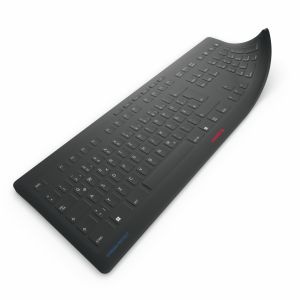
High-resolution color display (720p, 5”) for better readability and operation
Easily disinfectable touchscreen glass surface for optimal hygiene
Clear separation between patient and medical professionals
(Prepared) Reading and writing of contactless cards through 2 NFC interfaces (back and display)
(Prepared) Camera-based 5MP 2D barcode scanner for scanning data matrix & QR codes (e.g. ePrescription)
Flexible device orientation: 1. lying or 2. standing as wall mounting
One-handed operation
2 year warranty
Secure supply chain required. Available from the following sources:
Technical Details
| General | |
|---|---|
| Warranty | 2 years warranty |
| Cable-length | 6.56 ft |
| Max. storage temperature | 149 °F |
| Min. storage temperature | -4 °F |
| Scope of delivery | Manual, eHealth PIN-Pad, USB-A to USB-C Cable |
| System Requirements-Hardware | CHERRY ST-1506 (optional to PC with USB port) |
| Smart card | |
|---|---|
| Chip card types | ISO 14443A Cards, ISO 14443B Cards |
| Display resolution vertical | 1,280 Pixel |
| Display resolution horizontal | 720 Pixel |
| Display width | 50.000027 in |
| Display with touch operation | yes |
| SmartCard-Speed | 848 kBit/s |
| Status display of chip card reader | display icons, LED |
| SW interface | SICCT |
| Clock frequency | 1,200 MHz |
| Chip-card reader type | contactless |
| Master data | |
|---|---|
| Width of product without packaging | 3,15 in |
| Weight main product | 12 oz |
| Height of product without packaging | 2,56 in |
| Length of product without packaging | 6,69 in |

Easily disinfectable PIN-Pad for greater comfort and hygiene for patients and medical professionals
The CHERRY eHealth PIN pad PP-1516 is a modern and easily disinfectable solution for workplaces in the healthcare sector and is approved by gematik. Telematics infrastructure applications (e.g. eMP, NFDM, ePA) require the patient to enter a PIN. With the PP-1516 PIN pad, CHERRY offers the ideal terminal device for convenience and hygiene on the patient side.

Ideal extension for the CHERRY card terminal
The PP-1516 PIN pad complements the existing ST-1506 card terminal from CHERRY, which can already be used to optimally implement telematics infrastructure (TI) applications, some of which are mandatory, such as insured person master data management (VSDM) or secure communication in the medical sector (KIM). The easily disinfectable PIN pad is placed on the patient's side in medical facilities, making it easy and convenient to enter the PIN. In conjunction with the card terminal, the PP-1516 PIN pad ensures a clear separation between patients and healthcare professionals to make the workflow even more efficient and optimize hygiene.

Why is a PIN pad needed?
- Clear separation of patients and healthcare professionals
- Optimized hygiene through easier cleaning (no open card slots)
- Protection of the card terminal (e.g. to prevent damage to the terminal when entering a PIN)
- Prevention of loss/damage to security cards
- Better usability (e.g. for wheelchair users) - can be mounted vertically and horizontally
When is it necessary to enter a PIN?
| Use | eGK PIN required by patient | eHBA PIN required by LE | ||
|---|---|---|---|---|
| Read emergency data records (NFDM) (if activated) | ✗ | |||
| Write emergency data records (NFDM) | ✗ | |||
| Read electronic medication plan (eMP) | ✗ | |||
| Write electronic medication plan (eMP) | ✗ | |||
| Read electronic patient file (ePA) | ✗ | |||
| Write electronic patient file (ePA) | ✗ |
Future-proof preparation for e-prescriptions and other applications

- Thanks to the integration of contactless/NFC interfaces, the PP-1516 PIN pad is also prepared for extended telematics infrastructure applications on the hardware side. The NFC antennas are located on the back with card holder for longer read/write processes (e.g. eMP) and on the display surface for shorter read processes.
- The PIN pad is equipped with a 5 MP camera (for scanning data matrix and QR codes) for the fast and practical recording of e.g. e-prescriptions in order to increasingly optimize processes in pharmacies, surgeries and clinics. The use of these functions on the software side requires approval by gematik.
The PIN pad in a modern design has a color display with a touch surface for good readability of the displayed content. The PIN pad can be used both horizontally and vertically via a wall bracket. The PIN pad can only be used with the eHealth Terminal ST-1506 and can be integrated flexibly via USB either directly on the device or indirectly via LAN on the PC/laptop.











